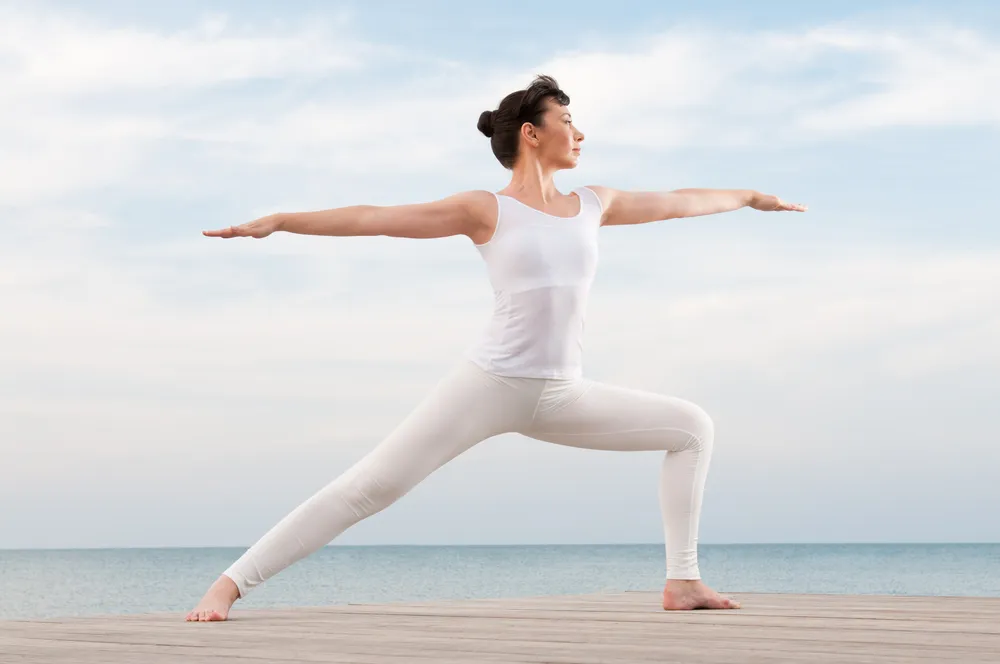Pregnancy brings with it tumultuous hormones and weight gain. While gaining some weight indicates good health of your foetus, being overweight could mean a health risk to you and your unborn. It could lead to gestational diabetes or premature birth. Even during the nine months of pregnancy, it is important to engage yourself in low-intensity exercises. It is obvious that gymming is not the right choice when you’ve conceived, you can opt for prenatal yoga. There are special yoga classes for pregnant women in which your physical limitations are taken into consideration and accordingly, the yoga postures are suggested. The asanas are often mild and do not stress any part of your body.
For every trimester of pregnancy, yoga can be practiced however, its intensity changes as your pregnancy progresses. It improves your stamina and posture thus eases your pain when your foetus is growing. Also it improves flexibility therefore, helping you during childbirth. Well, these are a few benefits of yoga during pregnancy; there are more advantages of prenatal yoga that a mommy-to-be must know.
Let’s find out some of the yoga postures that you can perform at different stages of pregnancy:
- Benefits of Mountain Pose
It relaxes your muscles and rejuvenates you.
- Practice Steps
- Stand with your feet straight. Both the legs should be placed at the shoulders’ gap.
- Lift the toes easily and then slowly keep them again on the ground.
- Meanwhile, rotate your thighs inward. This would widen your sit bones.
- Keep raising your hands above your head. They should also be placed at the shoulders’ gap.
- Your chin should be parallel to the floor.
This position looks like a normal standing position however, it has more to it. It strengthens your back which helps to ease your delivery symptoms.
Utthanasan (known as Squats)
Benefits of squats: It improves:
Blood circulation providing oxygen to the foetus
Digestion system
Strengthen lower muscles for an easy delivery
It encourages flexibility
- Practice Steps:
- Stand with your eyes concentrating on the front wall. Your feet should be three feet apart.
- Heels should face inwards and toes outwards.
- Raise your hands to the level of your chest, keep them straight and join the palms.
- Your hands should hang in front of you.
- Make sure your heels are not raised.
- Now to squat, gradually lower your buttocks. It has to be done slowly and patiently to avoid stressing on the lower body.
- Lower till you feel comfortable and now hold the position for a few seconds and come back.
- Repeat three sets of this posture with seven repetitions in each.
Warrior Pose

Benefits of this pose:It improves:
Stamina and strength
Balance
Concentration
Relieves high blood pressure
Treats backache
Eases symptoms of diarrhoea
Practice steps
- Repeat the steps of the mountain pose to initially stand in the same position.
- Relax from the first position.
- Your feet should be at least three feet apart. Now exhale.
- Raise your hands to bring them in front of your chest. The palms should face the ground.
- Both your feet should face outward. First move your right foot a bit and then your left foot should be placed at 90 degree facing the left direction.
- Do not move from your position, your thighs should be kept fixed. Move the left knee to be aligned with the left ankle.
- Hold this pose for a few seconds. You can make repetitions on the basis of your comfort. Ask your instructor to correct your pose.
Another yoga posture that you can try during pregnancy is titali asana, also known as butterfly pose. It works great to decrease the increased strain on your joints due to the additional weight of the baby. It requires you to sit on the floor with your legs stretched. Pull your legs inwards, join the toes and hold your ankles. Now try to move both your legs. Keep your back straight.
Why Yoga is essential to ensure smooth pregnancy and delivery?
- Yoga during pregnancy is considered an ideal exercise because it stretches your muscles which help you in the later stages of pregnancy as well as during childbirth. Secondly, it improves your strength and stamina to easily meet the demands of carrying the weight of your unborn child.
- Not only does Yoga aid during the three trimesters of pregnancy, it helps thereafter as well. It improves body posture which makes it easy for the new mother to easily carry the newborn while breastfeeding and otherwise also.
- Yoga during pregnancy means good reproductive health as a lot of stretching and toning ensures exercise of the reproductive organs and the overall body. Good reproductive health is synonymous with healthy and complication-free pregnancy followed by an easy delivery.
- During your yoga classes , you will be learning a lot of breathing techniques, you will learn how to control your fast, unbalanced breathing during panic attacks or when anxiety strikes you due to hormonal havoc caused by pregnancy. These breath control tricks would come handy during the last month of the pregnancy when delivery would be nearing. The techniques will pump more blood to your foetus as well as will keep it relaxed and provide sufficient oxygen. Therefore, yoga not only benefits you, but also the baby in your womb.
- Regular practice of yoga decreases your chances of going through a caesarean delivery. It increases the possibility of natural birth as all stretching exercises help your body by improving strength and building strength to endure the pain that accompanies a non c-section procedure.
- You might experience a lot of painful contractions during the last few days of your pregnancy. Yoga helps you to relax in such situations and recover from the pain.
- The biggest advantage of practicing yoga during the roller coaster ride called pregnancy is pain management. It teaches you to endure the pain and then fight it. This technique increases the strength of your body to cope with extreme labor pain.
- Yoga also improves concentration which helps in a great way to deal with the pressure of delivery the child naturally.
- During pregnancy, most of the moms-to-be go through extreme mood swings and complain of sudden emotional and psychological changes such as cravings for unhealthy food like pizza. By stimulating proper blood circulation and toning up the nervous system, yoga helps you to easily deal with the changes and do not react abruptly to any situation.
- The pregnancy may trigger some periodic diseases like gestational diabetes and prenatal depression. Even in some cases, the new mother goes into depression after the childbirth. This condition is known as postnatal depression. By practicing yoga, one keeps her mental and emotional state balanced and maintain peace with her own self.
- Yoga Nidra (commonly known as yogic sleep) is a great technique to regain the point of balance and harmony in every sphere of existence.
- The body becomes weak due to the additional weight that it carries in the form of the Even after delivery, a woman continues to feel weak and gets tired easily. By practicing yoga on a regular basis, one would feel recovering strength in the lower body as well as the pelvic and abdominal muscles will be relaxed.
A woman can get back to yoga after six to eight weeks of childbirth however, it is advised that you take permission from your gynaecologist before practicing any kind of exercise. Postpartum consultation is a must for both mother’s and her child’s health.
Precautions while practicing yoga during pregnancy
Pregnancy is a sensitive condition; any wrong move could cause you more loss than you may think. Therefore, it is advisable that before joining any yoga class, you go through the cautionary measurements to ensure your as well as your foetus’s well-being.
- The foremost advice is to search for an experienced, professional and certified yoga instructor who is aware about the nitty-gritty of yoga postures for pregnant women. He or she must understand the sensitivity of your bodily condition along with taking into consideration your medical records. It would be great if could share your pregnancy reports such as ultrasound or doctor’s prescription with your instructor. One who is qualified to train pregnant women must be well-aware with these reports.
- If any yoga asana is causing strain on your stomach, back or pelvic muscles, immediately stop practicing it and inform your instructor about your discomfort. Do not push your body to perform beyond its restriction- this could be dangerous for the life of your little one. During the last trimester of pregnancy, avoid engaging in such postures that require you to lie on your side or put pressure on your stomach. Keep it simple and sorted. The thumb rule to perform yoga during pregnancy is to avoid complex postures.
- Usually in a class meant for pregnant women, there are enough instructors to pay individual attention to everyone present there. If there is no one to support you while you practice yoga, take support of a wall or ask for a helper. It is highly important to avoid falls. Negligence could lead to miscarriage, premature delivery and irreparable damage to your foetus- all of which are scary situations and must be avoided at any cost. Do not take your safety lightly and do not hesitate from asking assistance whenever required.
Conclusion
Before you engage yourself in yoga during pregnancy, you must understand your body well. Pregnancy is a major bodily change which could alter your health forever. You must know how to communicate with your body and understand the various symptoms it presents. The pregnancy hormones might put strain on your muscles and may lead to pain in the connective tissues as well as in the lower abdomen. This condition may arise often between the fifth to the last month of pregnancy. During such time, avoid practicing yoga and get in touch with your gynaecologist at the earliest.
If your doctor has deemed you fit to enrol in a yoga class, don’t miss the chance. Yoga works on more aspects than just your physical health. It keeps your mental and emotional state in place, brings your spiritual side at peace and prepares you psychologically for the changes that will come after you welcome a new, little member in your life. Moreover, it can be performed at any stage of pregnancy- first trimester, second trimester, third trimester and post delivery. For easy and healthy conception, it is also advised at the preconception stage.
Recommended Posts For Yoga Beginners
Step By Step Guide Before Start Practising Yoga
Best Yoga Asanas to Lose Weight
Yoga for Reducing Weight and Increasing Stamina
Yoga vs Gym Which One is Better



